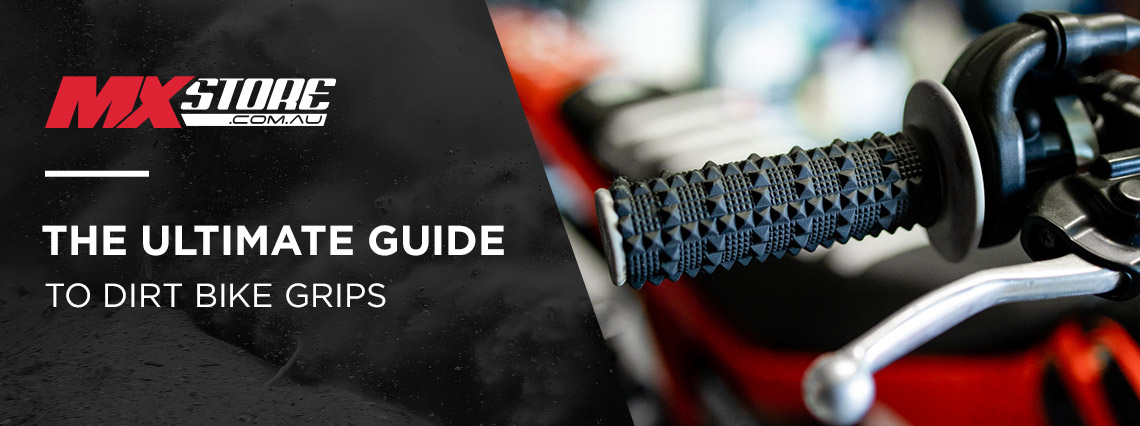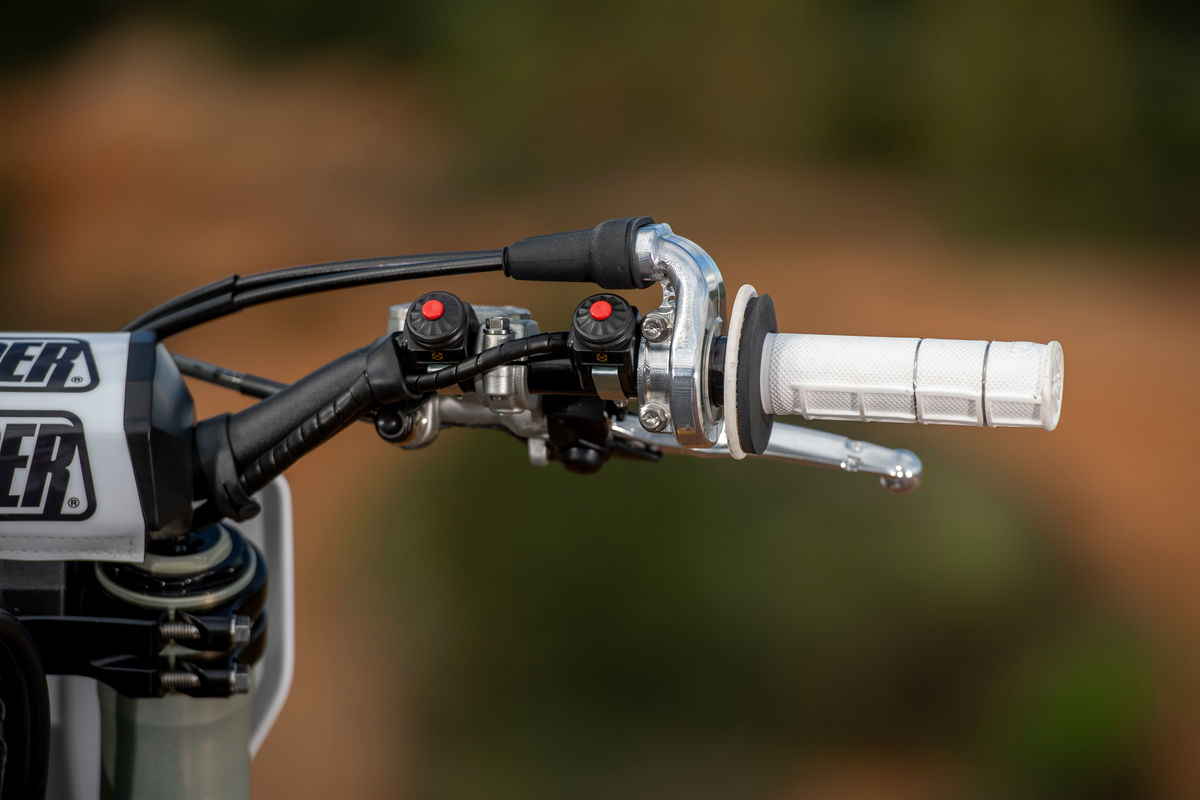Dirt Bike Grips: Buying Guide, Tips, and Tricks
 Dirt bike grips are a simple yet incredibly important component of your dirt bike, so you should be taking them seriously. Why? Well, grips are the main contact point between yourself and the dirt bike, so put some thought into choosing the right ones for you, and even more importantly, take the time to install them correctly to prevent an accident from occurring.
Dirt bike grips are a simple yet incredibly important component of your dirt bike, so you should be taking them seriously. Why? Well, grips are the main contact point between yourself and the dirt bike, so put some thought into choosing the right ones for you, and even more importantly, take the time to install them correctly to prevent an accident from occurring.
When should I replace my dirt bike grips?
Dirt bike grips are one of the cheapest components you'll need to buy for your motorbike, but when should you replace them? Well, there are three key signs you should look for.
1. Rips/tears/holes: One of the most obvious signs your grips need replacing are tears, holes, and any damage. Grips are made from soft rubber, so they're susceptible to ripping and tearing in the event of a crash. It can become unsafe if there is such damage to grips - the tears and rips can worsen while you're ripping motos, where the grip can completely rip off the handlebar and potentially result in the crash.
2. Excessive wear: The next sign you to replace your dirt bike grips is excessive wear, which can also lead to holes, rips, and tears. Excessive wear can be identified by inspecting your grips, and seeing if the raised rubber or 'grip' has been significantly worn down or almost flat with the grip itself. If this is the case, it's definitely time to replace your grips to prevent them from ripping or tearing while riding your motocross or enduro bike.
3. Sore hands/blisters: The next indicator you need to change grips is if you're constantly getting sore hands and blisters. Now getting blisters and sore hands can come down to many things such as technique and even the gloves you're wearing, but changing grips to a different style could also solve the problem. If you're finding you're getting excessive blisters and your hands are hurting, it might be time to try some new grips.

How do I remove dirt bike grips?
If your current off-road motorcycle grips are toast and ready for the bin, then you can simply cut them off with a stanley knife and ditch them. If your grips are being replaced yet are still in good condition and you want to keep them as spares, use an air compressor to push beneath the grip while twisting and pulling away from the handlebar. Find out more information in our How To: Remove and Install New Dirt Bike Grips.

How do I install dirt bike grips?
Installing a new set of motocross grips is a fairly simple process. The first step is to ensure the handlebar and throttle tube are clean and all remaining glue from the old grips has been removesd. Following that, apply a dedicated moto grip glue inside the grip and in a line across the handlebar/throttle tube. You can now work the grip onto the bars (ensure grips at both ends are lined up correctly). The grip glue will set and if you want extra reinforcement, you can use grip wire as a secondary method of securing your grips. If you have lock-on grips, it's simply a case of sliding them on and securing them into the position with an allen key. Lock on grips incorporate a new throttle tube, so on the throttle side, you'll need to remove the old throttle tube and reconnect the throttle cables to the lock-on grip. Find out more information in our How To: Remove and Install New Dirt Bike Grips.
What is the difference between dirt bike grip types?
Grips come in soft, medium, and hard compounds, but you may also find dual compound grips. To add another layer of confusion, you'll find waffle, half waffle, diamond, and pillow top grips.
As a general rule, hard grips will last longer and are durable, however, they are tougher on your hands and can cause blisters. Medium and soft compound grips will be less durable but aren't as harsh on your hands which can make riding more enjoyable and help you hold on for longer.

Full Waffle:
Full Waffle grips consist of rectangular-shaped boxes around the entire grip - this type offers a great amount of grip on the bars (especially in wet conditions!), although it does come at the cost of being harsh on your hands.

Half Waffle:
Half waffle grips are one of the most popular options - they will consist of the same rectangular-shaped waffle pattern boxes, although only halfway around the grip. The other side of the grip features a diamond-shaped 'tread' pattern, and this type is more forgiving on your hands.

Diamond:
Diamond grips are exactly that - a full grip consisting of the diamond pattern. You'll usually find these in soft and medium compounds, and they're generally a 'thinner' grip than their counterparts. This a really popular option amongst riders.

Pillow top:
Pillow top grips are essentially filled with 'pillows' of elevated rubber, and the most common offering is the Pro Taper Pillow Top. There are usually two types: a thick profile (standard pillow top), and a thinner profile (pillow top lite). Both are dual compounds and are easy on your hands, so they improve comfort, but the thickness can impact feeling and has been found, in some cases, to increase the likelihood of arm pump.

Kevlar:
Kevlar grips, most notably by Renthal, offer a mix of durability with a softer compound, and have a 'sticky' feeling. This is a more expensive grip, although you do generally get an extended amount of riding from them.

What are lock-on grips?:
Lock-on grips are exactly what they sound like - they lock onto your handlebars, rather than requiring grip glue and safety wire. ODI pioneered lock-on grips and introduced them to the dirt bike world, they're now widely used as the preferred grip for many riders. Lock-on grips come in a variety of the grip compounds and styles listed above, and they're generally secured to the bar by a pair of hex-head fixings. This makes for a super simple and quick replacement process. The throttle side also includes the throttle tube which is moulded into the grip. It is important to note, lock-on grips are generally more expensive than traditional grips.
What are grip donuts?
Grip donuts are an accessory that some riders choose to use to prevent blisters and reduce arm pump. The donuts slide onto the grips, providing an extra buffer and cushion, these are particularly popular amongst off-road racers.
Dirt bike grip tips, tricks, dos and don'ts:
No grip glue: If you happen to be stuck without grip glue and still want to change a pair of grips, you can always use an aerosol spray contact cleaner as the lubricant. Spray a small amount inside the grip before sliding it onto the bar will make them slip on easily and will dry with a non-greasy residue. Don't forget secure your grips with grip wire!
Keep things secure: As we mentioned at the beginning of this guide, grips are the key contact point between yourself and the bike you're controlling, which is why it's incredibly important to correctly secure your grips with glue or grip wire. Failing this will cause grips to twist which in worst case scenario could cause an accident or injury.














